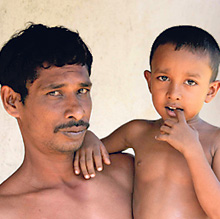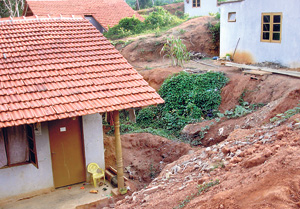Hambantota -- Ajit Prasanna, a former fisherman, sighs with relief as he looks at the expanse of green in his garden and outside. But he is unlikely to forget the crisis his family and others in the village of Malgampura in the Hambantota district went through whenever it rained in their new homes in this southern coastal village.
“It was not only a great stink but I also had to take my family and run to higher ground, every time this happened,” he recalled, sweeping his eyes over the nice patch of green around his home compared to a mud-splashed residence – more than 18 months back -- surrounded by puddles of water. Prasanna, a victim of the December 2004 tsunami that swept through thousands of homes in Sri Lanka, said: “It was as bad as the tsunami.”
 |
| Ajit Prasanna and son. |
Soon after Prasanna’s family and others moved into this newly-built and hilly post-tsunami housing scheme a kilometre away from the southern beaches in early 2006, rain water swept into their homes and not only flooded them out but resulted in the shallow latrine pits spilling over into the yard and often into homes.
Oxfam, which has been working on post-tsunami housing projects with another international humanitarian organisation, World Vision, and concentrating mainly on water and sanitation needs for the new homes, had heard about the crisis at Malgampura and wanted to help. “It was probably the worst tsunami housing scheme built after the tsunami. There was no plan for a proper drainage system and proper latrines,” noted Jagath Swarnalal, a water and sanitation engineer at Oxfam’s office in Hambantota.
When he heard about the flooding and sanitation problems, Swarnalal remembered the site because he had visited it before when residents reluctantly were moving in. Among the biggest challenges in post-tsunami rehabilitation was the reluctance of fisher-folk, to move inland to newly constructed homes as re-construction was being banned on the shore. For fishermen and their families who had lived for decades on the beachfront, this decision came as a major setback.
“Initially we complained about the distance from the sea but later got used to it. We didn’t have a choice because we didn’t have a place to stay,” said U.H. Susantha, a 38- year-old fisherman, who still goes out to sea. “For many months we didn’t have proper latrines as these were filled up with water. The smell was terrible.”
Swarnalal visited the site and was confronted with serious problems at the housing scheme where the residents were desperately looking for a solution. “There was a major problem about drainage and disposal of sewage,” he said. Since it was a hilly settlement with no proper drains, the water flowed down the hillside during heavy showers washing away the gravel/mud roads and flooding homes with muddy water on the way to the bottom. Water from the soakage septic pits also filled the yards and homes. During that June 2006 visit by Oxfam staff to the scheme, 80 out of 100 houses were occupied and all of the occupants had a series of complaints. In half of the 100 houses toilets could not be flushed on rainy days due to the limited capacity of septic tanks, about 20 earthslips were blocking the surface drainage, mud flashes were inside 70 houses and five houses were constantly flooded. Some of the inhabitants feared to sleep inside the houses during rainy days due to possible flooding, according to Oxfam staff.
 |
| Crisis situation: What the housing scheme looked like |
Dharme Bandara, Programme Coordinator, Oxfam Hambantota, said, “There was a crisis here. Moved by their plight we offered to help.” Oxfam had some unused funds from other completed water and sanitation projects which were directed towards this project. “It was not much – Rs. 14 million – for a project of this magnitude. But we mobilized the community and got them involved – to save on costs,” he said.
Residents were requested to form a committee which was then told about the quantum of funds Oxfam could afford to spend on the project. The community was asked to join together and make this work effective within the available financial resources. “The community pitched in well and the work that we did jointly wouldn’t have been possible if we handed it over to a private contractor,” recalled Bandara. Villagers were told to provide quotations for raw material so that in the procurement they would ensure the prices were reasonable, and also have some transparency in the project. In many cases these quotations were accepted. In some cases labour charges to dig up pits were paid to villagers. “We simply couldn’t ask them to provide free labour as they were also without a proper income,” said Swarnalal. The masons and other skilled labour came from outside the village, also recommended by the community – making sure the village got involved in every aspect of the work. To save costs, where simple pits or grass turf could be used in place of more expensive septic tanks and concrete embankments, this was done. At every point the villagers were consulted.
 |
| Proper drainage and embankments |
The project was completed in February 2007 and the floods were a problem of the past. Toilets functioned with proper soakage pits. Functional surface drainage made the environment attractive while earth embankments prevented earthslips.
Oxfam officials particularly Swarnalal were greeted with a lot of enthusiasm and cheerful shouts by villagers as they walked through the village during a recent visit with a team of reporters from The Sunday Times. “Ah Mahattaya,” greeted one woman, adding, “Now everything is fine. God bless you.”
|



